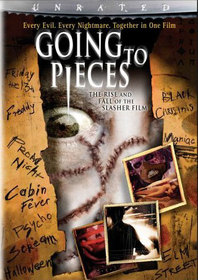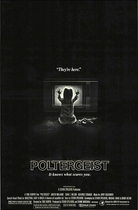Our editor-in-chief Nate Yapp is proud to have contributed to the new book Hidden Horror: A Celebration of 101 Underrated and Overlooked Fright Flicks, edited by Aaron Christensen. Another contributors include Anthony Timpone, B.J. Colangelo, Dave Alexander, Classic-Horror.com's own Robert C. Ring and John W. Bowen. Pick up a copy today from Amazon.com!
Going to Pieces: The Rise and Fall of the Slasher Film (2006)
Studying a genre is like studying a species. You learn its diversity, habits, evolution, demise, and idiosyncrasies. You learn its strengths, weaknesses, and characteristics. You learn its habitat, context, and place in the ecological, social, and historical order. Regardless of the genre, the exercise is challenging and engaging.
Going to Pieces: The Rise and Fall of the Slasher Film does an admirable job of surveying the genre’s breadth and commercial value, but its analysis of the genre’s aesthetic and cultural importance screams for more details, and ultimately, it becomes a victim of its own fascination. Standing in awe of the slasher film’s appeals, the film and its makers forget to fully document its hypothesis, that slasher films are complex films rich with political, historical, and aesthetic value. Thus, we’re left tantalized, but rarely convinced.
Based on Adam Rockoff’s critically acclaimed 2002 book of the same title, Going to Pieces (GtP) ultimately serves more as an advertisement for the book than an independent documentary. The film opens by superficially exploring the historical and cultural origins of slasher-related violence by using anecdotes from the ancient Romans and their obsession with gladiator violence and Victorian-era obsessions with Jack the Ripper. GtP then makes an awkward leap into modern cinema, arguing that Hitchcock’s Psycho and Michael Powell’s Peeping Tom, two classics from 1960, launched the genre. Fast-forward two more decades to John Carpenter’s seminal Halloween, and the template was established for a revolution in horror filmmaking. This opening would work much better if it didn’t cover so much material so briefly.
Carpenter is then interviewed, and his commentary on the zeitgeist of the late 1970s, particularly news events such as the Jim Jones Kool-Aid massacre in Guyana and the political failures of the Carter administration, is noteworthy. However, GtP glosses over the details of Psycho, Peeping Tom, and Halloween, and essentially skips The Texas Chain Saw Massacre and Black Christmas, while obsessing over lesser films such as Prom Night and Friday the 13th. The latter two are certainly important in the genre’s evolution, and the commentary on Friday the 13th and its commercial success is valuable, but ultimately, when looking at the genre holistically, viewers will be left scratching their heads wondering why so much attention was given to individual floor tiles instead of pillars.
With guest appearances from heavyweights such as Carpenter, Wes Craven, Tom Savini, and Rob Zombie, GtP then outlines the fundamental characteristics of the genre: plots haunted by faceless killers suffering from traumatic psychological pasts who, familiar with the film’s setting, terrorize virginal females through a series of subjective-point-of-view camera shots. The documentary raises two additional points that warrant further analysis: many slasher films occur during holidays, a phenomenon suggestive of the ritualistic nature of the killing and terror; and the influence of Italian horror masters Mario Bava and Dario Argento and their impact on the genre, particularly their graphic use of blood.
However, the film skips three equally important points: the reliance of film noir lighting and cinematographic techniques so prevalent throughout the genre, and the symbolic meaning of the genre’s emphasis on specific types of sharp, piercing weapons such as knives and axes. This latter dismissal is curious since the killers’ “slashing” motions define the genre. The third curiosity is the lack of any significant treatment of the “final girl,” an important academic theory linked directly to the genre. The feminist implications of that theory have helped transform the genre from pure entertainment into an important socio-political phenomenon.
Nevertheless, the film wisely focuses on the zeitgeist of the Reagan-led 1980s and its effects on the genre. As a decade defined by excess, AIDS, body culture, Cold War politics, conservatism, the ascendance of religious fundamentalism, and feminism, there was plenty of anxieties to pass around, which is why the genre blossomed. GtP aptly notes that one of the genre’s key mantras, the idea that the films’ characters often pay for sins of their youth, aligns nicely with Reagan’s conservative philosophy. Another interesting section is the commentary offered by Gene Siskel and Roger Ebert in the 1980s. Their venom toward the burgeoning genre is intense and misguided, especially since hindsight has shown that the slasher genre is more important than these two icons originally perceived. Even giants can make mistakes. But as is typical with GtP, the film simply mentions these points without any real examination of them; each potentially warrants a book chapter, which is why this topic is so challenging to cover adequately in an 88-minute documentary.
The documentary concludes with an analysis of the second and third waves of slasher films ushered by Wes Craven’s A Nightmare on Elm Street in 1984 and Scream in 1996. That early slasher films helped launch the careers of prestigious actors such as Jamie Lee Curtis, Kevin Bacon, and others, and then later, with Scream, helped solidify the careers of rising stars such as Neve Campbell, Rose McGowan, and Jamie Kennedy, has given the genre commercial legitimacy to mainstream audiences.
Overall, the documentary bounces around too often, neglects important details, and fails to identify the actors and films it showcases. This last criticism may have been deliberate to reveal how repetitive, and thus self-effacing, the genre was; however, such repetition may be more a sign of weakness. Covering too much material and leaping over too many important details will compel viewers to want more. Thus, its treatment of the “slasher species” shines when covering its diversity, but that luster fades when trying to explain that diversity. The documentary also never adequately explains the genre’s periodical hibernations and resurrections. For example, if the genre exploded during conservative political times, why did it re-emerge during more liberal ones, as was the case in mid-1990s with Scream?
No doubt the filmmakers love and know their slasher films, but they could have done better in packaging that passion to viewers. The genre deserves that type of in-depth study since this documentary will only whet one’s appetite. Then again, that may have been the point… there is always Rockoff’s book, which has received critical attention, particularly for the passion it displays for slasher films.








